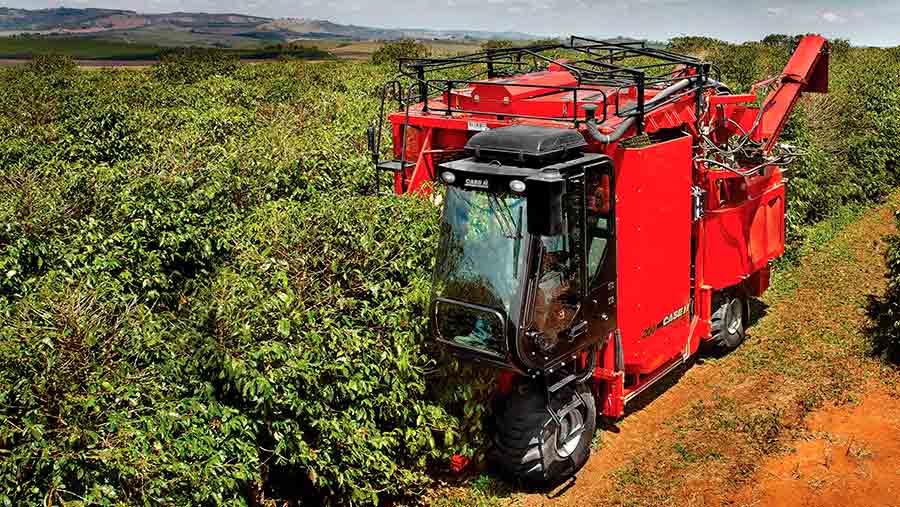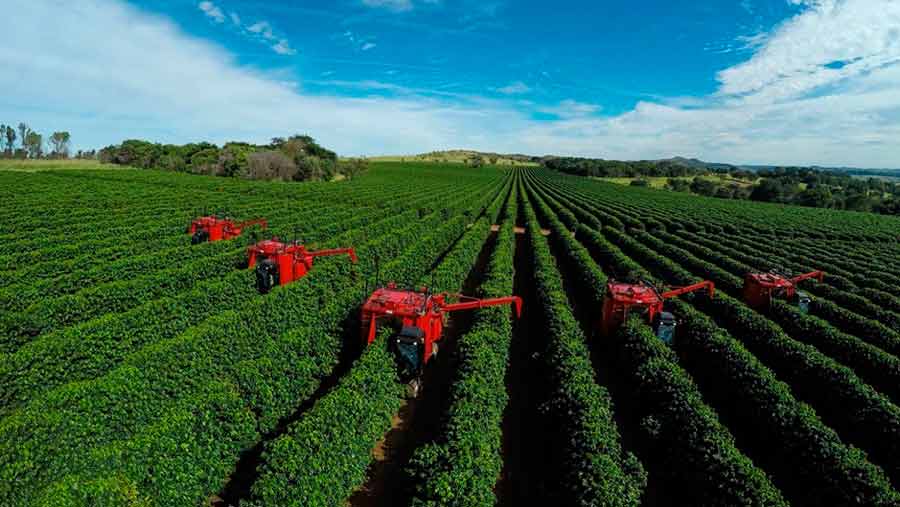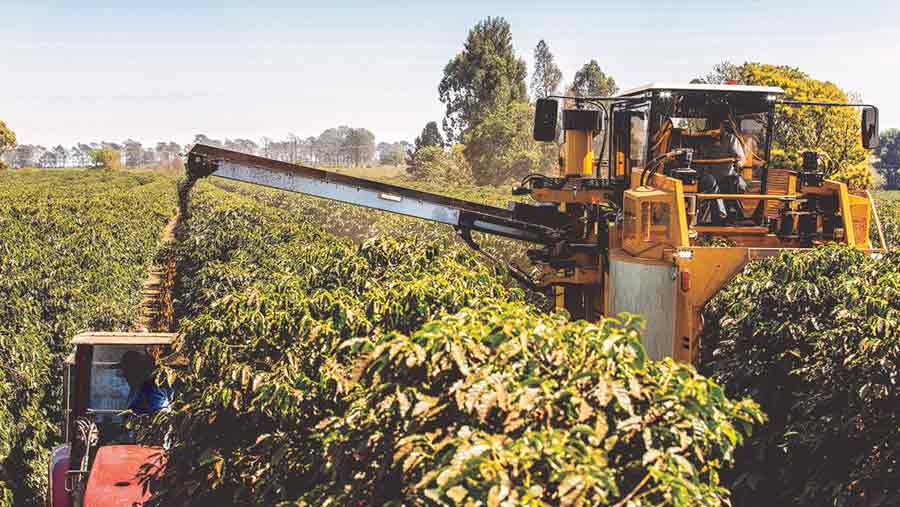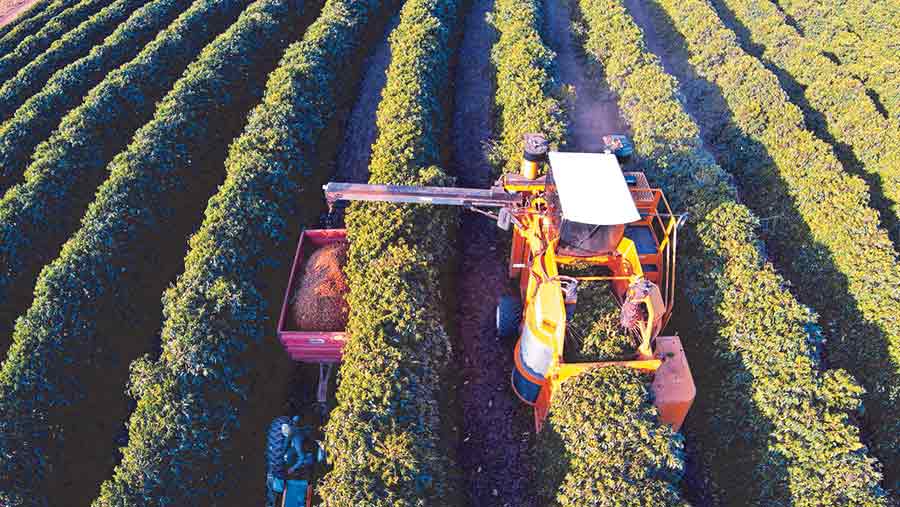Unusual and exotic harvesters: Coffee

There is a mechanical harvester for virtually every crop in the world and coffee is no exception.
Somewhere between 1.5bn and 2bn cups of coffee are drunk every day across the globe – the world can’t seem to get enough of it.
In fact, coffee consumption is set to grow strongly in the next five years as China and other emerging countries become wealthier.
It’s no surprise that coffee is now the world’s most valuable agricultural commodity and the second most valuable export after oil. Whether you swig a cup of basic instant or savour a posh Nespresso, the beans need to be harvested.
Before we get to the nitty-gritty of the harvesting, a bit about the crop.
See also: Exotic and unusual harvesters – sugar cane
Which countries grow coffee?
According to the International Coffee Organisation (ICO), worldwide production is about 8.6m tonnes. The leading producers are Brazil, Vietnam, Columbia and Indonesia.
Coffee needs an average yearly temperature of 24-27C and is grown in the so-called coffee belt that straddles the equator.
There are two main commercial types of coffee bean – Robusta and Arabica. Robusta has a coarser taste, a higher caffeine content and grows best at lower altitudes. It is also easier to harvest. Arabica is better suited to higher altitudes and has a richer taste.
An even rainfall of about 127cm and no frost are key requirements. A coffee tree will take four years to mature, be at its most productive between years five and 10 and can yield fruit for up to 30 years. But it does need fertile soil.
The best-quality coffee is made from the ripest berries. Farmers face a trade-off between harvesting only those ripe berries and coming back for more later or keeping costs low by harvesting all the berries at the same time.
Coffee exhibits the typical price volatility associated with an internationally traded commodity.
In 2002 Brazilian growers faced a low price of 31c/lb, but by 2011 were enjoying a level of US$2.24/lb. It now averages $1.10/lb, with a range from 75c for Robusta to $1.50 for the best mild grades.

How do you harvest the crop?
About 60 million people are engaged in growing the crop, with the bulk of it harvested by hand. Machines are only used on the larger plantations, where the ground is more level and regular spacing of trees can be achieved.
In this respect, mechanical coffee harvesting – which has been around for 30 years – requires conditions similar to those for sugarcane harvesters. The market is shared between Case IH and Oxbo, although there are local machinery manufacturers in Brazil, China and India.
Coffee plant variety is important to the efficiency of the harvester. The ideal is a bush that ripens evenly, is not too tall and has a bare base.
Case IH
Case IH produces two machines, the trailed Coffee Express 100 and the self-propelled 200. The technology is similar to grape and citrus fruit harvesting – the harvester straddles the coffee trees, then a pair of large vertical spindles fitted with spines or rods rotates and rattles the coffee plants.
There are 34 flanges with 24 rods on each making a total of 816, with the rods made from fibreglass-reinforced plastic. The degree of vibration or shaking can be adjusted by a wobble box and so can the speed of the spindles.
Set it to a low level and only the ripest beans will drop. Set to a higher, more vigorous action and all the beans will be harvested. However, care has to be taken not to damage the trees by setting the vibration to too aggressive a level.
Stripped and shaken
The beans are stripped or shaken loose and fall to a fishplate conveyor made from polycarbonate plates mounted on springs. This mechanism is similar to that of a grape harvester.
The conveyor takes them up to the holding bin, then passes a set of fans that blow away unwanted leaves. The beans can either be put into boxes or loaded into a tractor and trailer that runs in the next alley, so the spout goes over the row inbetween.
Unlike many of the machines featured in our unusual and exotic harvesters series, high horsepower is not a prerequisite – the self-propelled machine has a modest 55hp, which drives all the hydraulic pumps for harvesting, cleaning, the fans and conveyor.
Harvesting speed is between 0.2 and 1mph, which puts it in the running for winner of the slowest farm machine category and explains why only a modest horsepower is required.
While growing temperatures of 27C and tropical downpours might be alien to most Farmers Weekly readers, the option of automatic steering will be familiar.

Oxbo
Oxbo Corp, parent company of Ploeger and PMC pea viners, purchased the Korvan brand in 2004 and has fully upgraded the machines. Its largest machine harvests at up to 1.2mph, which translates to about 3t or 2ha/hour in a crop yielding 1.5t/ha.
If the grower is aiming for higher quality, however, this output will be halved as only the red berries are picked, leaving the green ones to ripen for a second pass. The main difference from the Case is that the driver sits on top of the machine in the centre.

Shaker speed
Case positions the cab next to the trees, which apparently makes it easier for the driver to see the ratio of ripe to unripe berries on each tree and adjust the shaker speed accordingly.
Processing starts by drying the berries. Laying them out in the sun and regularly raking them is the low-cost method that takes about four weeks. During the night the berries are covered to prevent dew forming.
Mechanical dryers can reduce this time to four days, but are much more expensive.
An alternative is to use the wet method. Here the berry pulp is removed in a pulping machine. Water is used to wash away the sticky outer layer and to sort the immature beans from the mature ones.
The wet beans then ferment, which helps to remove the skin, although a demucilager can also be used to reduce stickiness. After a final wash the beans are dried before being put through hulling machines to remove the parchment. Each berry produces two coffee beans.
The beans are then sorted and graded before being packed into 60kg bags. They are green when they leave the plantation and only turn brown after roasting and blending. Roasting produces the aromatic oils that give coffee its distinctive flavour. The longer the roasting, the darker and stronger the coffee.

